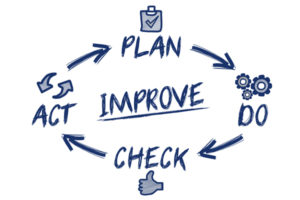Why Ditch the Annual Performance Appraisal?
-

We love to collect data on performance for nearly every aspect of our lives. We purchase expensive watches to track heart rate, steps, and burned calories. We monitor the speed we drive, how many hours of sleep we get, calories consumed, cups of coffee we have each day, kids’ grades, sporting statistics, and the list goes on. Even at work, we record our time on task using time sheets, monitor our department budgets, submit expenses, and meet client deadlines. Simply put – we crave performance feedback and devote much time, energy, and money in obtaining that feedback in nearly every aspect of our lives (the primary exception being an accurate measure of our vices!).
Despite our craving for performance feedback, employees and their managers despise the annual performance appraisal. Many articles have been written about the ills of the annual performance appraisal and indeed some firms claim to have “ditched” the annual performance appraisal. Given that we know learning cannot occur without feedback, how can we take advantage of peoples’ natural craving for feedback to deliver impactful performance appraisal at work?

Companies are now realizing what I/O psychologists have been arguing for years – that a once-a-year checkup isn’t enough. Traditional end-of-year appraisals overemphasize past behavior and in many instances hold employees accountable for results months in the past. A yearly appraisal also amplifies common rater errors such as recency effects (rating on recent behaviors rather than the entire year) and halo/horn errors (letting a single trait influence the entire rating). An obvious problem is that yearly appraisals are not motivating or correcting because employees are not receiving feedback for 12 months! The types of feedback employees do crave occurs daily, within the context of a specific goal, and without the specter of financial rewards and punishments looming over them.
Although results-oriented feedback is important to monitor, another aspect of feedback we crave is to focus on process rather than outcomes/results. This is a critical distinction because we often cannot control outcomes. All we can control are our behaviors and the process by which we carry out our daily tasks. For example, we purchase Fitbit to monitor the number of steps we take, heart rate, and calories burned because these process behaviors lead to improved health. Health outcomes such as accidents or genetic abnormalities are outcomes out of our control.
In much the same way, performance appraisals focused on the process behaviors for success will likely lead to results. More importantly, these behaviors are under the control of employees. In contrast, many results/outcomes are the result of conditions outside our control such as political upheaval, market conditions, change in leadership, and competitors. Feedback is more motivating when we are held accountable for the behaviors under our direct control. The problem of course, with frequent feedback on process behavior is how to scale it. It is difficult for supervisors, a common source of feedback, to give continuous monitoring and feedback. The good news is that technology can help automate feedback at work in much the same way that Fitbits have automated behavioral feedback. For example, there is wearable technology such as sociometric badges (developed and sold by Massachusetts Institute of Technology) that measure performance and engagement at work. Computer programs also measure performance such as time spent on task and number of contacts made with customers. Tips to better performance ratings: a. Let managers manage. If managers are so overworked they cannot provide frequent feedback then the job could be restructured. b. If wearable technology is not available, find sample performance templates from companies such as AOE Science or popular text books such as “The Performance Appraisal Tool Kit.” c. Encourage your direct reports to send you the calendar invite for their performance feedback and ask them how often they want feedback. This gives them ownership. d. As an organizational leader make it fun to do performance appraisals. Create some healthy competition by sharing metrics, publicly rewarding high performance departments (e.g., pizza parties; half days off), and announcing new goals. e. Ask employees to conduct a self-evaluation that you compare to your own evaluation. f. Measure process behaviors and *not* attributes. g. Some Simple Steps: - Goal Setting & Planning - Ongoing Feedback & Coaching - Formal Appraisals and Rewards